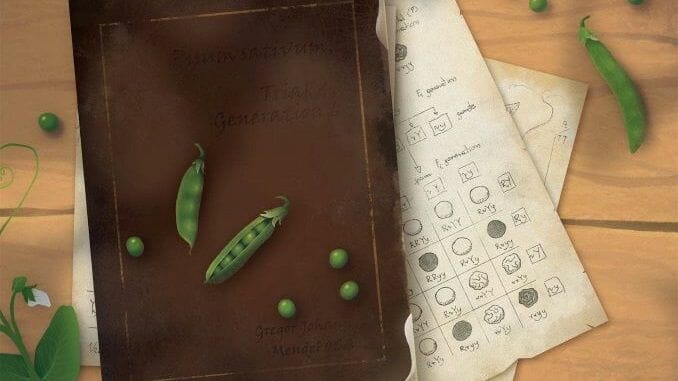Genius Games has been churning out science-themed games since 2014, scoring a hit with the acclaimed title Cytosis, which earned them the endorsement of the Journal of Cell Science for its commitment to scientific accuracy. Their newest title, Genotype: A Mendelian Genetics Game, is their best yet for combining scientific content with actual gameplay and great graphics. It’s their most visually appealing game, and of the ones I’ve played it’s also the most fun—the sort of game where players might learn a thing or two without realizing it.
This is a worker-placement game at heart, however, and you place your spade tokens on the board first before anyone drafts a die. One action is to claim dibs on the first die from a specific row (trait) on the board. You can also pick up new plant cards, or new tool cards, which confer one-time benefits like covering a trait of your choice for free. You can use a worker to take two more coins, or to claim a scoring bonus for all cards with a specific expression—say, two more points for every purple pea plant you’ve completed. And, if you’re very science, you can even place a worker in a space that allows you to mess with the genetic stock, so that you can cover one side of the Punnett square to contain only dominant genes or only recessive ones, altering the value of all dice in that row until someone else takes the same action to undo yours.
The game lasts five rounds, and you only have three workers at the start of the game, so your number of actions is fairly limited. One of its best aspects, however, is that the workers don’t limit your dice drafts—you can use a worker to claim the first die from a row, but after those players have chosen, everyone gets to draft dice until everyone has either filled their three dice slots or can’t match a die to an open trait. At the end of each round, players can also spend to buy upgrades—an extra plant slot, an extra die slot, another worker (up to five total), or an assistant that provides permanent and often very powerful benefits for the rest of the game. The game plays from two to five players, with a solo mode, and suggests a playing time of 45-75 minutes, reasonable given the lack of simultaneous actions in the game.
I showed the game to a botanist and former middle school biology teacher, who also happens to be my mother-in-law, and she gave the game her own seal of approval. In addition to appreciating the layout—all of the genetics stuff is on the left side of the board, and the right side has what I would call the business actions—she thought the implementation of the Punnett squares through dice-drafting was likely to express the concepts clearly even to younger players who hadn’t yet encountered them in school. The design choice to put the relevant terms—homozygous dominant, heterozygous dominant, and homozygous recessive—at the top of the board, in smaller print, also earned plaudits.
I am a strong advocate of the power of games to teach, whether it’s simple arithmetic, deduction, communication, or teamwork, but Genius Games makes incorporating math and science part of their mission. Genotype feels like a culmination for them—and it was years in the making, first appearing in a very different form as a prototype at Gen Con 2019. It’s an educational game, but more importantly, it’s a fun one.
Keith Law is the author of The Inside Game and Smart Baseball and a senior baseball writer for The Athletic. You can find his personal blog the dish, covering games, literature, and more, at meadowparty.com/blog.

